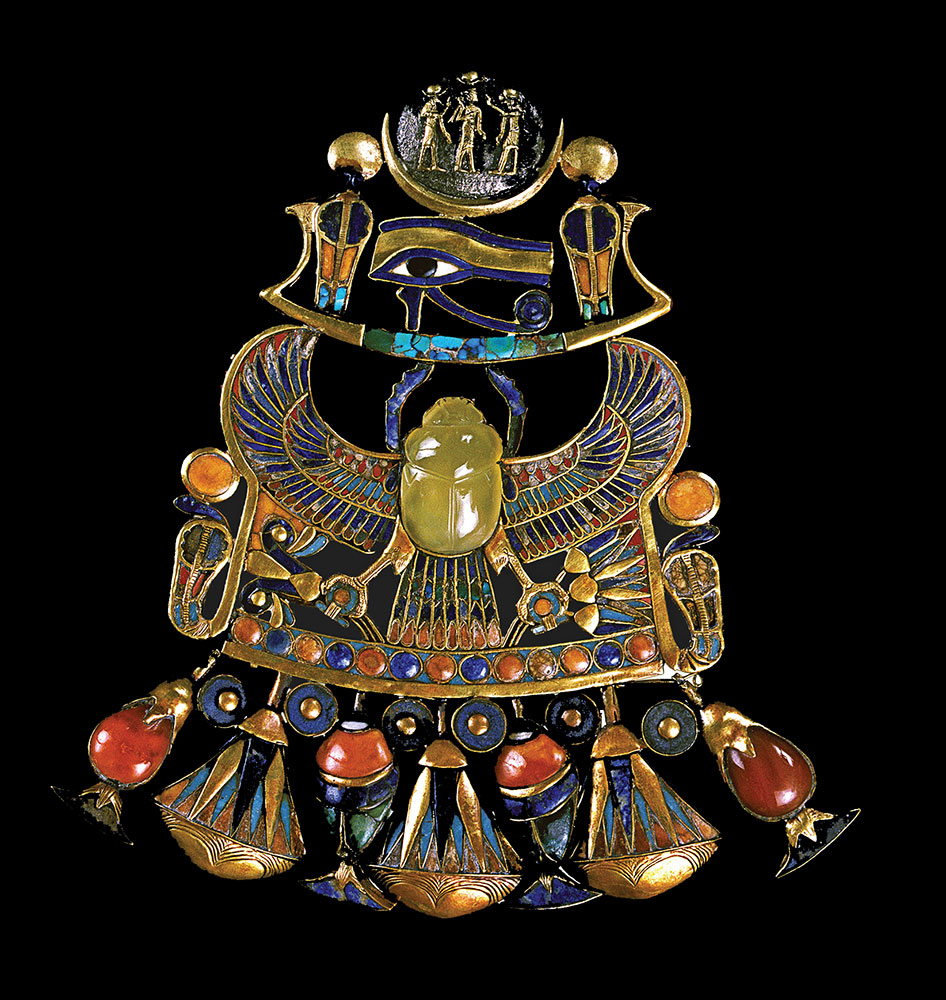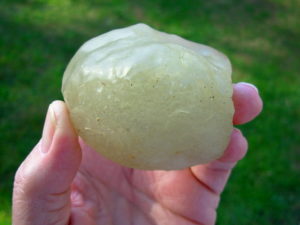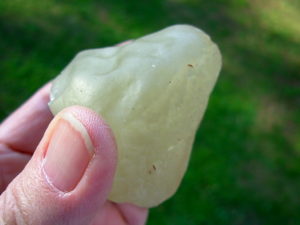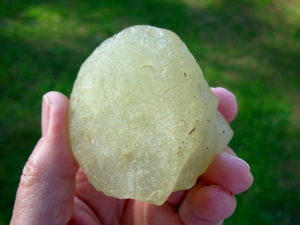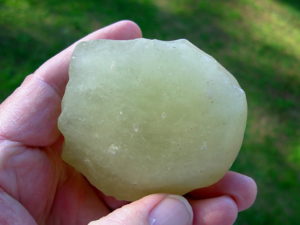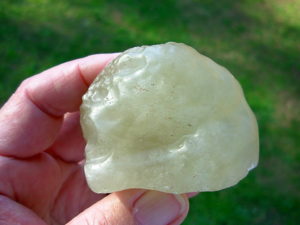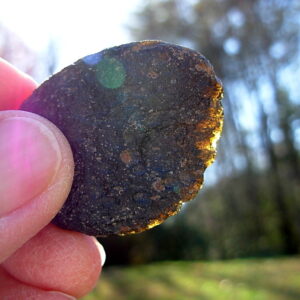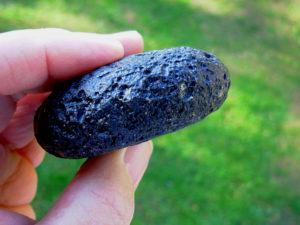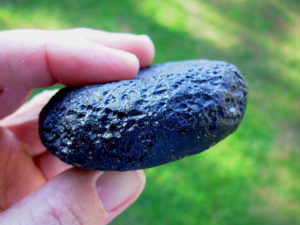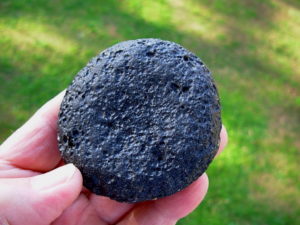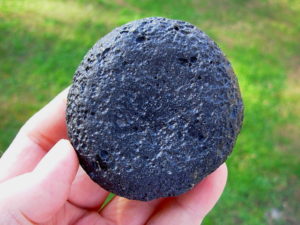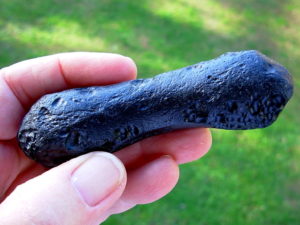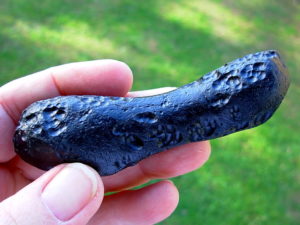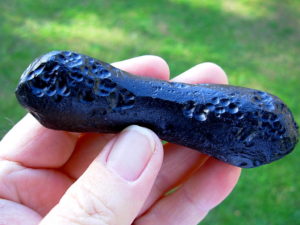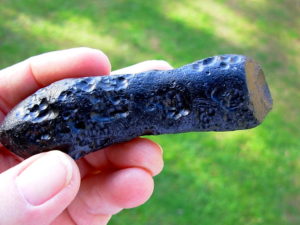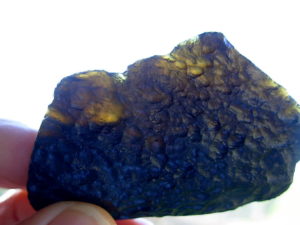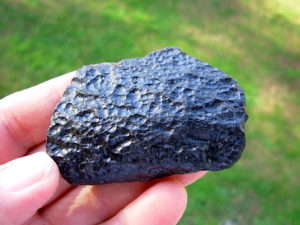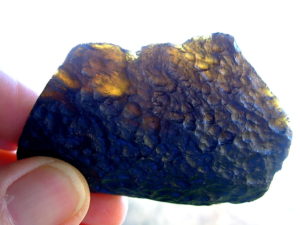Tektites and Desert Glass
Tektites are found in areas where asteroids, comets or meteors have impacted with the Earth. A number of previous theories describing their origin have been discussed, including coming from lunar volcanoes or lunar impact events. These theories are no longer taken seriously by scientists. It has now been scientifically agreed that tektites are terrestrial rock melted and blown into the atmosphere by the explosive force of an asteroid, comet or meteor impact. The tektites form as the molten rock is solidified while being cooled as they fall back to earth through the atmosphere. Tektites are specimens composed of black, green, brown or gray natural glass formed from these extraterrestrial impacts. They may range in size from tiny millimeters to large centimeters. Millimeter sized tektites are known as micro-tektites. Tektites are found in many shapes and sizes. The different morphologies are restricted to impact sites and occur in a radial pattern as they are blown away from the source crater. The name "Tektite" is from the Greek meaning "Molten".
Most tektite strewn fields are associated directly with a specific impact event. Moldavites with the Ries Crater in Germany, Ivory Coast Tektites with the Bosumtwi Crater in Ghana and the North American Tektites with the Chesapeake Bay Impact Crater. The impact source of the Australian Tektites has not been found but it is suggested that it may be the result of an aerial burst similar to the burst over Tunguska, Siberia or the burst that produced the Libyan Desert Glass in Egypt. Satellites have identified a 100km circular impact cone off the Vietnam coast in the South China Sea which is believed to have produced the "Indochinite" Khan-Ku, Thailand Tektites.
Libyan Desert Glass Libyan Desert Glass is found in Egypt in an exceptionally remote area. The natural question then follows ... Has any Desert Glass been found in Egyptian tombs? It has...it was found In King Tut's tomb. The photo below of King Tut's breastplate (from the King Tut Museum Exhibit) shows a carved yellow scarab as it's centerpiece. For many years it was thought to be made of chalcedony; this scarab has now been confirmed to be Libyan Desert Glass.
So the history of the world stumbles upon collectibles throughout time. It is difficult to be definitive about ancient stones as they really did not know the now common geological names for their precious and adorning stones. Translations of ancient writings lead to speculation and educated guessing as to the type of stones and minerals that were found in a specific area at a specific time frame. Stones were normally referred to by their color in ancient times.
New findings of tektites constantly occur as more and more people begin the quest to find the elusive Tektites. Tektites should be a part of every meteorite collectors treasures. The more we learn about our Earth's interactions with the extraterrestrial universe, the more our imaginations, theories and that never ending drive to discover new frontiers, leads us to learn all we can about our universe.
The Australasian ( biogeographic region that includes Australia and the islands adjacent to it, including New Guinea, New Zealand, Polynesia, and Tasmania) Strewn Field is by far the largest in the world. Australasian tektites are found in most of Southeast Asia, including Vietnam, Thailand, Southern China, Laos and Cambodia. The strewn field also includes the Philippine Islands, Indonesia, Malaya and Java. It extends into the Indian Ocean and the western side of Australia. Approximately one tenth of the Earth’s surface is included in this strewn field.
Australites (tektites found in Australia) are generally very dark or black in color. Thin edges or broken parts will have a yellow or brown color when examined with back lighting. They have a wide range of forms including the traditional Teardrops, dumbbells, spheres, rods, discs and all types of irregular shapes. In Australia aerodynamic button shaped tektites are found. Their rounded cores that remain when they fly apart while passing through the atmosphere look like designer buttons.
Item# LDG11150629
Libyan Desert Glass Huge 170g Rare Tektite
$219.00

We got this specimen many years ago from Wally Marks at the Highway 50& 95 Rock Shop. It has been in our personal meteorite display for over 12 years.
This specimen weighs 6 oz or 0.375 lb (170g) and measures 2.47 x 2.38 x 1.86 inches (62.9 x 60.5 x 47.3mm)
Thailand Splash Form Tektites
Thailand tektites are part of the Indochinite strewn field. The location of the impact structure, or crater, which formed these tektites is believed to have been located by satellite as being 100km impact crater in the South China Sea. The volume of tektite glass in south east Asia seems to indicate that it is near the Vietnam / Thailand area. Thailand received a good portion of black, shiny, and well formed splash form tektites found in Thailand. Dumbbells, Teardrops, Rods, Patties, Spheres, and all the various in between forms are found in this region of the Indochinite strewn field.
Large numbers of new specimens are not being made available from Thailand so very high quality older specimens show how really nice this material is. The surface texture is rich with bright shiny cups and pits. The surfaces show the twisting of the molten glass in visible surface flow lines. The ever present bald spot is generally found on all larger splash form tektites and that is the case with Thailand splash forms as well.
Item# KKT11150622
Old Stock 186g Patty Indochinite Tektite

We got this specimen many years ago from a mineral dealer from Khan-Ku, Thailand. Found in the Australasian Strewn Field in 1994
This specimen weighs 6.5 oz or 0.41 lb (186g) and measures 2.8 x 2.6 x 1.1 inches (71 x 66 x 28mm)
Item# KKT11158991
Old Stock 94.5g Dumbbell Indochinite Tektite

We got this specimen many years ago from a mineral dealer from Khan-Ku, Thailand. Found in the Australasian Strewn Field in 1985. Measurements are 1st length, then dumbbell end, center, end. This is an old stock quality specimen from our personal collection.
This specimen weighs 3.3 oz or 0.2 lb (94.5g) and measures 3.9L x 1 x 0.7 x 1 inches (101mm long x 27 x 18 x 26mm)
Item# AUST11152285
Old Stock 40g Australite Tektite
$129.00

We got this specimen many years ago from a mineral dealer from Australia. Found in the Australasian Strewn Field in the early 1980's. This specimen from our personal collection shows yellow to brown on thin side when backlit. This is smooth flow on one side and lots of thumbprints on the other side. Photos were taken in outdoor sunlight, holding the piece up to the sky
This specimen weighs 1.4 oz (40g) and measures 2.4 x 1.8 x 0.12 to 0.46 inches (63 x 47 x 3.1 to 11.7mm)

